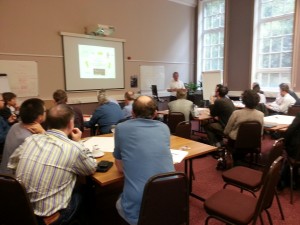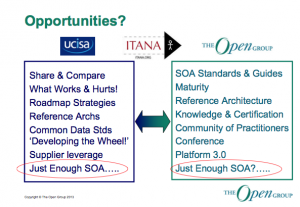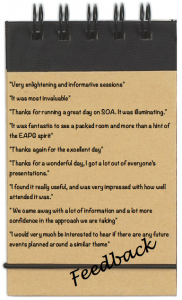Some time ago, at a UCISA Enterprise Architecture event, I discussed whether we needed a workshop for Higher Education (HE) sector technical architects to get together and share knowledge of Service Oriented Architecture (SOA). Whilst enthusiastic, colleagues expressed concern at the time that possibly the sector was too immature in this area for any individuals within it to be able to contribute to a worthwhile discussion. However I was not keen to host a vendor-led event as sometimes these can introduce an unhelpful level of product bias and not necessarily highlight the pitfalls to avoid when pursing a SOA roadmap in an HE institution.

Since that time I bumped into several colleagues from other HE institutions at various events and began to realise that there was a lot more SOA activity going on around the sector than I’d maybe thought. The people I spoke to were very encouraging about the possibility of a SOA knowledge exchange and some obvious speakers began to emerge. So I organised the SOA Knowledge Exchange at Bristol. I only had 40 places and they were filled within five days of advertising by UCISA and the JISC, clearly demonstrating that this is a hot topic for many of us. The workshop took place last month and here is a summary report of what went on.
I presented the first session, briefly describing our SOA roadmap at Bristol (much of which is detailed elsewhere in this blog) and explaining how I managed to reach the ears of our senior level decision-making body last year. I talked about how, as Bristol’s Enterprise Architect, I am able to take an holistic, enterprise-wide approach, and to articulate to non-technical, key strategy-makers, the problems that our complicated, point-to-point architecture cause us. Taking a SOA appproach should reduce the costs of maintaining our data architecture, reduce data redundancy and duplication as well as save us the embarrassment of system breakages caused by data changes in a master system rippling in an uncontrolled way through the systems architecture and causing data failure. However, implementing a SOA solution will require investment and at Bristol we see the road to SOA maturity taking years not months. We are beginning with a year-long foundation stage. I talked about this and the work we are doing to document our current integration architecture: the interface catalogue and the enterprise data dictionary (I also talk about these elsewhere in this blog).
Next up was Simon Bleasdale from Cardiff. He talked about how Cardiff is taking an iterative approach to enterprise application integration. Cardiff are building in-house skills through the creation of data integration and application integration teams and their approach is project-focussed. Simon described their range of data services so far developed using Restful Web Services via a combination of Grails and Mule. Having previously invested in IBM software, Cardiff are now conducting a review of this and plan to explore whether Talend or WSO2 would be a good future option for their University. They are committed to taking an agile, open source, simple and cost effective approach to data integration.
Allister Homes from Lincoln followed Simon to describe their current technical architecture in terms of their early work on master data management (MDM) and deploying Enterprise Service Bus (ESB) technology using Microsoft Biztalk. He discussed how a combination of MDM and ESB is enabling Lincoln to distribute data via their Sharepoint and Customer Relationship Managment systems to a range of application services across the institution. He also read out a highly entertaining and very apt paragraph that Lincoln put in their SOA business case for senior management, likening the current experience of their digital communities to that of dwelling in a primitive, unintegrated town settlement and describing the vision of the future as analogous to a thriving ‘metropolis’ with properly integrated services.
Martin Figg and Russel Gibson from Imperial gave a tour of the issues currently faced at their University and progress to date. Imperial have implemented SOA solutions for sharing HR organisation hierarchy data and research data with other IT systems and are now working on building data security into the architecture by integrating with their Authentication As A Service (AAAS) solution. They have worked on building SOA infrastructure in a standardised way to support generic error handling, reporting and resubmission. They are continuing to try and build strong SOA governance to stop the proliferation of point-to-point interfaces between systems and to promote the standardised reuse of data services to replace them. They have at least 6 skilled staff working in this area, with other staff in various supporting roles, including a SOA consultant to help answer particular queries. Some really interesting questions were raised in this presentation about the implementation of Enterprise Business Objects (EBO’s) and Enterprise Business Services (EBS’s), and the hard design decisions they’ve been facing in configuring the generic Oracle Business Suite to work best for their HE-specific purposes.
Cal Racey brought us up to lunchtime with a presentation on Newcastle’s SOA and Institutional Data Management work to date. He described Newcastle’s institutional data feed service (IDFS) which delivers data to over 30 of their systems via 70 different feeds. This came out of the JISC funded IDMAPs project and is currently supported by the equivalent of two full-time staff. They are using Talend. Cal advocates a light-touch data dictionary approach, avoiding going down rat holes with data structuring and modelling and also warns against the distractions of endless battles around whether to choose a SOAP versus REST approach, XML versus JSON data formats and so on. He also recommends continuously identifying where master data is held and what new master data an application produces. Cal described the importance of measuring the data problems right at the start so that it is possible to evidence the success of SOA-based solutions and thus build the case for continued SOA investment.
After lunch Jim Phelps joined us virtually from the States where it was 8.30am his time! He is Enterprise Architect at UK-Madison University and also chair of ITANA. He gave us a presentation that first described the Push Notification architecture they have introduced at Madison and then went on to talk about ITANA’s work. Some interesting stats on technologies being deployed by US Universities in a recent survey: the majority are using WSO2’s open source stack, probably because of the fairly large developer skillset in this area over in the States. The survey picked up just one Oracle SOA Suite institution, one IBM institution and some Fuse source. For more information on Jim’s excellent work, see ITANA’s SOA API Wiki: http://goo.gl/evbpk5 and the W-Madison AIA Wiki: http://goo.gl/xblJS4

David Rose opened our final speaker session, joined remotely by Chris Harding, Director For Interoperability at the Open Group. The pair gave a very useful, wider context to the whole day, talking about completed and current projects being undertaken by the SOA Work Group. Current projects include SOA for Business Technology, SOA Reference Architecture V2 and SOA Certification. Resources from completed projects can be found online (http://www.opengroup.org/). They also talked about Cloud readiness and the relevance of SOA to this. They went on to discuss whether the HE Sector could create a Reference Architecture that would evolve over time and enable both a language for conversations (and leveraging power) with suppliers as well as help individual universities to develop their SOA architectures. They finished with a thoughtful slide on the potential relationship between UCISA (with its Enterprise Architecture group), ITANA and the Open Group (shown above).
And the conclusion? This event didn’t feel like the blind leading the blind by any means and the feedback has been excellent (a selection of which I’ve recorded here). If we can keep up the momentum I think something very constructive could come from this initial effort to collaborate. Hopefully we can work on a reference architecture for our sector, share emerging SOA design patterns and perhaps we can begin to influence key vendors by clearly specifying our common data architecture requirements… Many thanks again to all the speakers and for the great input from those who joined us as participants. It was a very enjoyable day!

Nikki,
Thanks for an excellent workshop. I certainly plan to keep in touch.
I’ve written my thoughts on where we are with SOA on my blog: http://distributed-thinking.blogspot.co.uk/2013/10/patterns-for-service-oriented-it.html
Dave.
Hi Dave,
Your blog post makes a really interesting read – thanks for providing the link. I must admit that we’ve considered at Bristol whether to use our data warehouse (which is used for Business Intelligence) also as an operational datastore, but we err on the side of not doing this because, despite the lure of realtime data possibilities, the creation of star schemas etc. for BI reporting carry a development overhead and are optimised for fast data access to create reports rather than to respond to operational data demands. I’m always open to considering this differently, though, as technologies evolve.
I agree with you that it would be interesting to explore SOA design patterns further and to investigate where providing read-only master data solutions become too limited for particular scenarios where event driven solutions are most needed in a modern University system architecture.
Thanks for coming to the workshop and asking some great questions!
Nikki
It’s very interesting knowing knowledge about data architecture and share the thought’s. http://www.tateberry.com